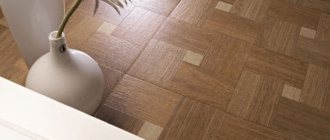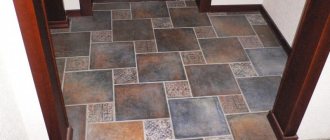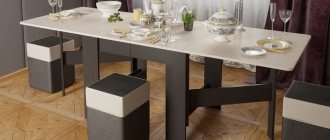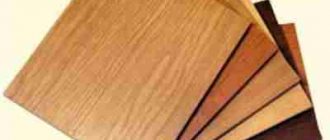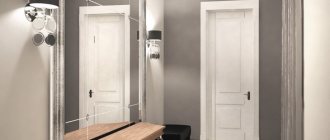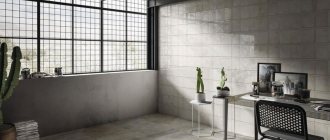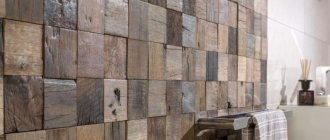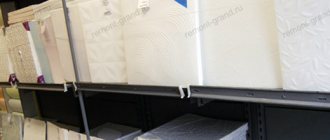What determines the standard size of floor tiles?
There are three main modern types of floor tiles.
- Ceramics - this includes both plain, even square panels, and mosaic elements or their imitation. This is the option with the widest price range - from cheap serial issues to rare broomsticks or products in the Moroccan or Portuguese style (“azulejo”).
- Porcelain tiles are more expensive than ceramics in the basic version, more durable. Depending on the complexity of the design and additional additives, the price increases. Popular sizes – from 30x30 cm.
- Quartzvinyl is a composite material made of PVC and quartz chips. Durable, lightweight, easy to install (easily glued or connected with locks, much easier to adjust to the required parameters).
Separately, you can select tiles that imitate a wooden floor or parquet. At first its size did not differ from large slabs, but later their geometry became closer to the wooden original. So, the following panels look most natural (in centimeters):
- 15x45;
- 12x60;
- 15x60;
- 19x60;
- 20x60;
- 14x66;
- 15x66.
Black ceiling in the interior: trend or nonsense?
It would seem that everything is clear with a black ceiling in the interior - it will put pressure on you psychologically and visually make the room smaller. Or not? We tell the whole truth.
Porcelain stoneware is stronger than ceramics, so panels made from it tend to be larger in area. Metlakh tiles, which can be laid out in a pattern, can have a variety of parameters, but mostly small ones.
The dimensions of quartz vinyl largely depend on the design and method of connection, but most often these panels are larger than porcelain stoneware.
Porcelain tile thickness: how to choose
Encyclopedia mapPorcelain stoneware is one of the most popular facing materials used as flooring for furnishing apartments, houses and offices. It can also be used as a wall covering for swimming pools, terraces, and building facades.
The water absorption of porcelain stoneware is quite low and amounts to 1%. Therefore, the frost resistance of the stone is high and laying it outdoors or in an unheated room can be very effective.
The material is suitable for covering stair steps, which always bear high weight loads. Due to its high wear resistance, the stone does not lose its original appearance during long-term use. The material is not subject to deformation, its service life is up to 100 years. It is fire-resistant, does not crumble, and is easy to clean during use; any chemical composition can be used.
What should you consider when choosing this material so that its operation is as efficient as possible?
In particular, what should be the thickness of the porcelain floor tiles, since this parameter may vary depending on the installation method and the characteristics of the floor.
Modern technologies have made it possible to add aesthetics to porcelain stoneware.
The slabs are manufactured with the following modifications: - giving the surfaces an appearance similar to natural materials: wood, stone, metal; — application of various textures and patterns to the surface; — the use of various coloring substances; - imparting unique physical features: different roughness values of the tiles, changes in thickness, original molding (linear and complex shapes).
Porcelain tiles come in several types: technical, glazed, polished, matte, semi-polished, satin, rectified, structured.
The technical material is similar to natural stone (granite) and is wear-resistant. The cost is significantly lower than other types. It is used to create floor coverings in industrial workshops and warehouses. The tile received this name due to the lack of additional surface treatment. The advantage of the material is that it does not react to the influence of an aggressive environment, and the rough surface without treatment eliminates the sliding effect, increasing the safety of the work process.
Glazed stone is obtained by applying glaze. It has a beautiful appearance and is quite durable. The most expensive type of material contains an additional layer of substance that allows, after firing, to give the material a different surface color. They are most often used in residential buildings or luxury establishments, where the aesthetic beauty of the flooring is very important. However, it is not very practical: the surfaces can wear off over time.
Polished porcelain tiles are similar to a mirror (polished) slab. It is obtained by treating the base of the stone with abrasive components. The cost exceeds all other varieties. The disadvantage of a polished surface is that it cannot be used in open areas (balconies, terraces, verandas, etc.), since exposure to natural precipitation causes destructive processes on the front side.
Matte material is the most inexpensive, it is not subject to processing, only grinding the front side with coarse-grained wheels. Therefore, the outer surface does not shine or slip, but looks very presentable.
Semi-polished stone is obtained from the matte version by cutting away its surface and then polishing it.
Satin – material for decorative finishing. Before firing, mineral salts are applied to it. Has a shiny front surface. According to its quality characteristics, it is a weak material (compared to other types of stone); it cannot withstand heavy loads.
Structured stone is obtained by applying gold leaf or etching. The thickness of the slabs comes in 10 and 11 mm. A lower value will affect the strength characteristics of the product. Such requirements arise due to the relief of structured tiles. In places where there are depressions, its thickness will be critical, and the increased load will cause deformation. The slabs look beautiful on the floor, giving the impression of parquet, fabric or leather covering. The surface does not slip.
Rectified material is used as monolithic coatings: it can successfully cover seams and joints.
Clay, sand and feldspar are used to produce stone. It is produced in the form of slabs. Finished coatings sometimes differ in color from each other; it is difficult to obtain identical shades. Manufacturers try to create sets by carefully selecting slabs that are close to each other in color characteristics.
The main parameters are weight, thickness, size and color. The service life of the material, the installation location (outside or inside buildings), appearance and service life depend on how they are combined with each other.
There is a pattern: the greater the thickness, the stronger the porcelain tiles. Accordingly, a product with an increase in thickness will be able to more easily withstand physical stress and impact, which will make it possible to adapt the tiles to use in various rooms. However, there are certain factors that can adjust the process of laying and using tiles.
Porcelain tiles are produced in different widths and thicknesses. According to the standard, the thickness of porcelain tiles is from 0.7 to 1.2 centimeters. Certain rooms require less thickness or, on the contrary, allow the use of more durable and thick products.
The base for laying porcelain stoneware must be completely smooth. The presence of elements of old paint, plaster or residues of various solutions (cement, lime) is unacceptable. For installation, a special glue is used, which allows the material to be tightly fixed to the surface. The method and methods of installation depend on the size of the material.
Ultra-thin porcelain tiles
The thickness of such tiles is no more than 0.4 centimeters, the width and length are about 50 centimeters. The advantage of this type is its cost. The disadvantage is low strength relative to physical load. It is worth laying ultra-thin porcelain tiles only in those rooms where the flooring will not be subjected to intense and regular loads. For industrial complexes and offices, this board can be used as a final coating. Also, with such a thickness, laying tiles is more difficult than in the case of larger products.
Such slabs are laid on completely flat surfaces. If when laying other categories it is possible to align them using glue, then in this case such a technique is unacceptable. When cutting ultra-thin and thin material, great precision is required; with any careless movement, the tile will burst and will not be suitable for further use.
An important condition during installation is the absence of air-filled voids between the tiles and the base. If these are present, the already low strength of porcelain tiles will be significantly reduced.
When there is already a ceramic coating on the floor, and there is no need to remove the previous layer, the technique of laying new slabs on top of the old ones is used. Since the thickness is insignificant, the new layer will not affect the height of the room, which is important. When working, it is necessary to carefully transport the slabs from one place to another.
Porcelain tiles of standard thickness
—
A thickness of 0.7-1.2 centimeters is typical for standard porcelain tiles. This is the most common material. It is intended for laying floors in residential and office premises, industrial buildings, concert halls, sports complexes, shopping and government centers. The sizes of slabs in this category range from 50x50 mm to 600x600 mm. Popular tile dimensions are 30x30, 33x33, 45x45 mm.
The technical characteristics of this type of porcelain stoneware slabs allow them to be used anywhere. Experts believe that such material is the most reliable, effective and cost-effective.
Thick porcelain tiles
Porcelain tiles with thicknesses of 11, 12 and 14 mm are considered thick. The thickest porcelain stoneware reaches 30 mm. Such slabs are recommended to be installed in places with very heavy weight loads. As a rule, these are buildings with a large flow of people. The slabs are laid on the floor or open areas.
Such slabs have some installation features: - the large mass of one product requires great physical strength for installation, and it is most reliable to use mechanical lifts; — thick porcelain stoneware slabs are laid without using an adhesive mixture, since the weight of the product creates a strong adhesion to the base.
A special feature of large products is their ability to give the coated substrates a more refined and strict appearance. For example, a floor laid with rectified slabs will look like a luxurious ceramic coating. Bases covered with large porcelain stoneware blocks look beautiful because there are far fewer seams during installation.
Slabs with an increased thickness of up to 2 cm are well suited for laying outdoors for car parks, paths in parks, etc. – they are not afraid of temperature changes and in winter they prevent the formation of ice in the areas of stairs and porches.
What sizes are ceramic floor tiles?
Ceramics are more fragile than porcelain stoneware, so if they are laid carelessly - if voids have formed in the cement - cracks may appear. If we are talking about mosaics or rare tiles (the same broom), then small volumes allow you to buy exactly as much as is needed for the room, thereby saving money and avoiding a lot of cutting.
Various manufacturers are trying to create exclusive products, so they are actively promoting lines with non-standard sizes and designs. However, almost all ceramic floor panels have standard parameters (length and width in centimeters):
- 10x10;
- 10x20;
- 15x15;
- 20x20;
- 30x30.
These parameters can fit both ordinary products and designer samples. Ceramics are often chosen for rooms where the load is light, such as the bathroom and toilet. Here the coating is less susceptible to abrasion, excessive weight and impact loads: unlike in the kitchen, there is no risk, for example, of dropping a heavy frying pan.
Glue layer
When planning the tiling, it is important to determine the total thickness of the application along with the tile. The amount of solution depends on both the material and the dimensions
The larger the tile, the thicker the glue is applied. You should not put too much mortar, because instead of the declared strength it will begin to flake. In addition, it slows down the drying time. 4-8 mm is enough for standard tile cladding.
The choice of adhesive and application thickness is important
To hold massive tiles on the surface of walls or floors, select an adhesive with a suitable composition. There are special mixtures that allow you to use a minimum amount of mass for reliable results.
Taking into account these features, the optimal finishing is selected; it will last for many years. You should not install overly strong and oversized tiles, because they place additional load on the base being tiled.
Thin porcelain tiles: design and texture
At the moment, there are more than five hundred different colors and textures in the manufacturers' line, with which you can create the basis for any design solution. It is also possible to order thin porcelain tiles of any color. To do this, you need to contact the factory and if there is a sufficient batch size, they will be able to produce porcelain tiles of any color especially for you.
The use of porcelain stoneware is justified to replace natural components. After all, this material is certified in accordance with international eco-standards. The materials used to make kerlite undergo scrupulous testing and comply with green building standards. Kerlite is safe for health and its use is especially justified in hospitals, schools and kindergartens. The most frequent orders relate to the texture of wood and stone, because these are the colors that allow you to feel surrounded by natural materials without harming nature.
It is also possible to imitate metal, marble, granite and other natural materials. This approach allows you to use any texture in the cladding of premises. This is especially useful if the client wants natural stone, but it is impossible to use it, for example, due to its heavy weight, then you can resort to using thin porcelain stoneware. Large format, ease of joining, minimal labor costs for installation allow you to achieve a continuous texture.
The price remains the same as when using stone, and sometimes it turns out cheaper.
In addition, kerlite is very easy to cut, so you can create various complex patterns that will fit perfectly into any interior.
Installation
Installing porcelain stoneware slabs is not much different from installing other finishes on a ventilated façade. Of course, it all starts with preparing the foundation. The walls are cleaned of dust, dirt, mold, and other finishing (if any).
They must be treated with deep penetration primer, no matter whether the walls are new or old. This will protect the main structure from possible damage by microorganisms.
- Frame construction. Only metal profile is used. The tree is not able to withstand such a load. The distance between the frame elements will depend on the size of the tiles.
- Arrangement of heat and waterproofing. New buildings must be insulated, but as for old ones, everything is at the discretion of the owner. Waterproofing is installed both under the insulation and on top of it. The insulation material is placed tightly between the frame elements and secured with wide-headed dowels.
- A small ventilated gap of 3–5 mm is left between the insulation and the decorative trim.
- Then they begin to install porcelain stoneware slabs.
Differences between tile and porcelain tiles for flooring
Often, property owners, planning to make renovations, ask themselves the question: what to choose as a finishing material - tiles or ceramic granite? Externally, they do not have much difference, but the main distinctive features of these materials lie in their manufacturing technologies. The composition of porcelain stoneware slabs includes granite chips, which are mixed with sand and clay, pressed and fired at elevated pressure and temperature. In this case, the tiles are obtained with a very dense and monolithic structure, having a smooth surface on both sides.
Due to its high density, granite ceramics have greater mass and water resistance compared to ordinary ceramics, which makes it impossible to lay it on ordinary cement mortar. To set porcelain stoneware slabs, a special construction adhesive with the addition of polymer components is required. The tile has a more porous structure, allowing the cement mortar to penetrate into it and form a strong adhesion to the back surface of the tile. At the same time, this structure of the tile makes it less durable compared to porcelain stoneware, which is clearly superior to conventional ceramics in hardness, strength and durability. Granite ceramics can be identified by small inclusions of granite chips in the texture of the material.
There are unfounded rumors among ordinary people that granite ceramics are unsuitable for installation in the kitchen for the reason that it will crack over time under the constant vibration of the refrigerator, and also due to its fragility, the floor will often have to be repaired after accidental falls of large kitchen utensils. However, in fact, granite-ceramic tiles are fragile only during transportation and storage, when there is no dense base under their flat surface.
When laid on a flat and solid base, the tiles can withstand mechanical loads of up to 200 kg/cm2 and are not afraid of any vibrations. According to the Mohs scale, adopted for assessing the hardness of minerals in relation to diamond (10 points), porcelain stoneware scores 8 points, ahead of natural stone and granite. And this is confirmed by practical examples of its use in production workshops, where heavy equipment drives across floors made of granite ceramics without consequences.
Thickness of tiles with adhesive
Let's go further. And so, let’s say the tile itself will be 10mm. thickness, and what thickness will it be with glue? Most glue manufacturers have already taken care of this and indicate the recommended thickness of the adhesive layer directly on the packaging (see table below). If such calculations are not given, you can easily do it yourself!
- If the floor is perfectly flat, 4mm of glue is needed
- If the tile is large in size 600x600, 7mm of glue is needed
- If the floor is not level at all, you need 9mm glue
Thickness of tiles with adhesive
The maximum thickness of ceramic floor tiles, already with an applied adhesive layer, is 30mm. It is worth considering that if your floor is not very level, it is better to first level it or fill it with a new rough screed.
We have determined how much glue is needed, but how exactly to apply the required amount evenly over the entire base? Everything is simple here too!
Not always, even an experienced master optimally determines and applies the adhesive solution. If you don't succeed the first time, don't despair. Use a notched trowel; it will accurately select the thickness of the glue and distribute it as evenly as possible over the entire surface, and the excess will be squeezed out from different sides.
To make the example clearer, I will give you an example of a sign that is located on the packaging of one of the well-known branded tile adhesives.
Glue consumption per 1m? (table)
| Side size of square tiles (using rectangular tiles) calculation based on area | Recommendations for using a notched trowel (size of trowel teeth) | Layer of adhesive application after pressing the tile (trowel angle 45°) mm | Layer of adhesive application after pressing the tile (trowel angle 60°) mm |
| Up to 5-7 cm. | 3mm | 1,1 | 1,3 |
| Up to 10 cm. | 4mm | 1,4 | 1,7 |
| From 10 to 20 cm. | 6mm | 2,1 | 2,6 |
| From 20 to 30 cm. | 8mm | 2,8 | 3,5 |
| From 30 to 50 cm. | 10mm | 3,5 | 4,3 |
| Over 60 cm. | 12mm | 4,2 | 5,2 |
It is worth noting that the width of the spatula should be chosen equal to the width of the tile, or slightly larger for more comfortable installation.
List of sources
- setafi.com
- polonest.ru
- pol-spec.ru
- obplitke.ru
- gidpoplitke.ru
- proplitki.ru
- centro-pol.ru
- BazaFasada.ru
- ceramir.ru
- www.optomgres.ru
- Author: Sergey
Share with your friends!
Grade of tiles.
Due to the fact that ceramic tiles are a product whose production involves complex technology, then, like all materials of this kind, they differ by grade. Upon completion of the production process, the tiles are sorted, and their appearance, dimensions and strength characteristics are carefully controlled. If any of the characteristics diverge from the norm, the tiles are rejected from the first grade. Not a single manufacturer plans to produce second-class tiles; production is aimed only at first-class material. Therefore, the volume of tiles that were not included in the first grade is known only after the final rejection.
Based on this, there is no point in looking for information on the grade on the tile itself; it is contained only on the packaging and bears the Italian designation in the grade column (scelta), respectively, “prima” - first, “seconda” - second, etc.
What is the difference between the varieties? As a rule, tiles of the second grade have color defects: uneven color or spots, as well as various surface defects: in the form of shells, sagging on the edges, geometry defects when planarity (curvature of the surface) or orthogonality (curvature of the sides) is violated. In terms of strength, these tiles also remain hard and wear-resistant.
Tiles of the second grade have a lower cost, but quality claims for such tiles are not accepted by the manufacturer.
When determining the grade of a tile, the greatest difficulty is in controlling the appearance, in which the tone of the tile is simultaneously determined. This operation necessarily involves a person, which is one of the rare processes in production that requires human participation. Control is carried out by an operator at a special stand. Therefore, in terms of appearance defects, there is a tolerance in a batch of the first grade of up to 5% of tiles with deviations or surface defects. In other varieties this percentage increases.
All information on grades, tone, caliber is printed on the packaging with the tiles, which also indicates:
- country of origin, - manufacturing plant, - manufacturing technology - name of the tile (its color in the series) - tile format (its nominal value) - caliber table for this format - tile caliber (for mono and gres) - tile tone - tile grade — number of tiles in a box in pieces and m2.
When ordering large quantities of tiles that contain different series, you should leave not only a reserve for repairs, but also packaging for the tiles. This will make it possible, if necessary, to obtain information on all points of interest in the batch, starting from the moment the tiles came off the assembly line, as well as to resolve disputes between the customer and the supplier, if any arise.
You can get additional information on ceramic tiles, their types, types, safety, installation and others in the “Useful information and articles about tiles” section.
